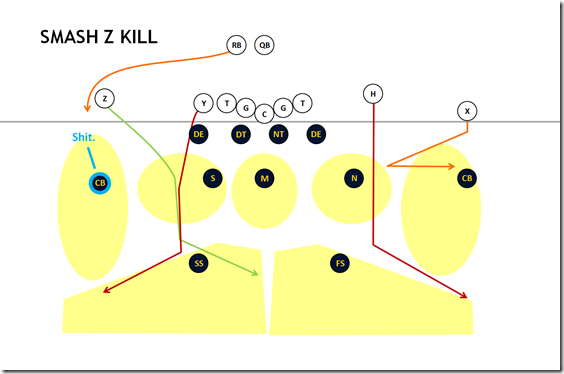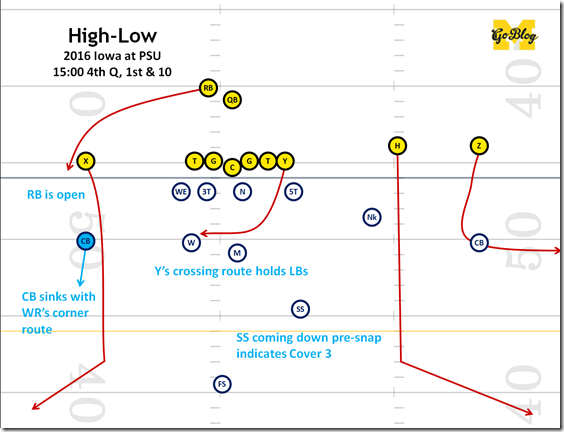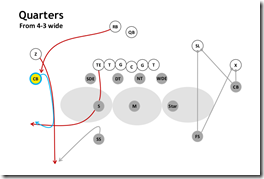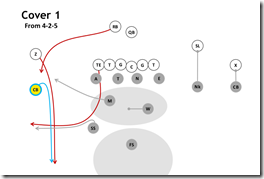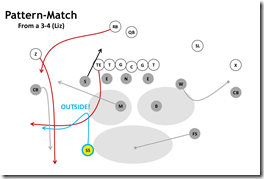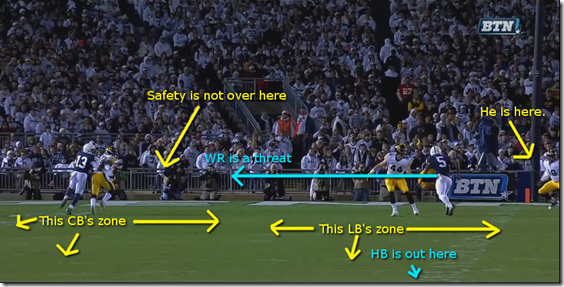Whatever you do, #44, it is wrong.
Iowa runs a base Cover 2 defense, and Michigan has been adding lots of Cover 2 to their Cover 1/Cover 3 base. Meanwhile Iowa’s offensive coordinator, Greg Davis, is well known for favoring a simple, West Coast-style passing offense that creates easy reads and, at the very least, open receivers underneath to dump it to.
All of that means it’s a good week to discuss a defensive concept we haven’t gone over in so long that the quarterback’s targets last time were Roy Roundtree and Martavious Odoms: a High-Low read.
If you’re a football guy already you can almost certainly tune this one out. If you’re not, this is a really easy thing to see on the field that can make you sound knowledgeable when you point it out to your friends.
High-Low Defined
This is an offensive passing concept that gives the quarterback two routes that cross above and below a defender’s zone, close enough to stay in view but vertically spaced enough (12-15 yards) that the flat defender can’t cover either by splitting the difference. The quarterback then throws whichever route the high-low’d defender covered.
I say “flat defender” instead of “cornerback” because it’s not always a CB who has that zone.
[After THE JUMP: lots of ways to stretch a man’s zone.]
Route Combinations
There are a lot of route combinations out there to create a high-low read, and various coaches have enough different terms for them that addressing them all won’t be productive. There’s a couple of them demonstrated in this old gif:
On the left side the TE runs a hook while the Z receiver runs a slant-corner. On the right we’ve got an RB leaking out to the flat while the WR runs a deep hook. But it’s not just CBs who get high-lowed.
The most common high-lows are “Smash” routes, a popular combo to create a high-low on the cornerback. A basic Smash has an inside receiver run a 12-yard corner route, and the outside receiver run a six-yard hitch.
Here’s Alabama running a smash on the right side on Oklahoma:
The #2 receiver took the safety deep then cut outside, necessitating the cornerback sink into the corner route, freeing up #7’s route underneath. The safety couldn’t stay on the #2 receiver because there’s a post coming across the middle.
And here’s what happens if the cornerback stays down on the shorter route:
The inside receiver was Gallon who ran a little flat route that puts him in the same underneath spot. The cover 2 cornerback (#2 at the bottom of the screen) stayed on him, which creates space for Jerald Robinson’s corner route. The linebacker who came over to stop a quick seam on J-Rob can’t stay on him forever, and the safety back there has to guard the hash. So it’s up to the cornerback, and once Denard sees the CB’s going to sit down that the 35 yard line he knows it would take a fantastic play by the Cov2 safety to stop a completion to the other extreme edge of his zone.
The other common route combination is to have the outside receiver run a flag route and the inside guy stems underneath, like so:
Gardner reads the CB, #9, who commits to A.J. Williams(!)’s quick out route and lets Gallon sneak behind.
A lot of offenses, Iowa particularly, loke to high-low with a running back as the low man. A receiver might be a big burly leapy guy, and getting him into a short route like the Alabama play above isn’t using your resources: he’s just kind of lazily walking to his spot, else he’ll get there early and just sit around. A running back on a swing route however can get the ball with a full head of steam, and then you’ve got your best ballcarrier isolated with a defender in a lot of space.
Or you get 3 YPA because you’re Iowa.
Flood concepts can run three receivers to a side, putting a high and low on the zones of both zone levels. Levels concepts run receivers across the defense at varying depths. Harbaugh’s beloved Y banana play is one such; it puts a high-low read on an outside linebacker:
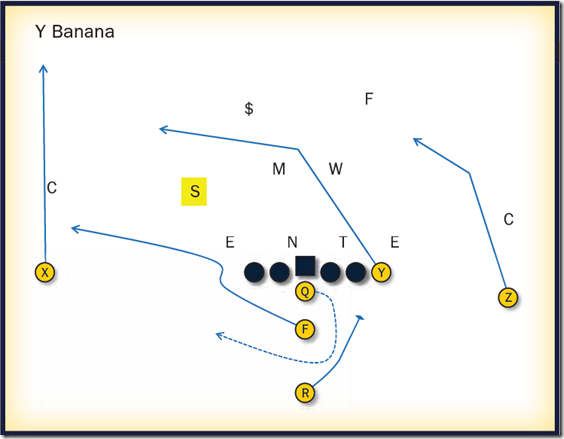
Isolating a Defender Requires a Diversion
Of course it takes other routes to keep pesky extra defenders from showing up to rescue their poor zone-stretched comrades. In the Y Banana play above the X receiver is drawing off the cornerback while the backside Z receiver’s route attacks the middle of the field, hopefull drawing safeties. Play-action should keep the MLB and WLB from getting enough depth to free those deep defenders.
For a cornerback high-low, usually this is done with a route that attacks the safeties between the hashes. Eric Streelman is a spread option coach/blogger I found because he uses MonuMental’s play-drawing program, and he’s got a favorite package that works about the same way:
This was also a favorite of Basketball on Grass, that Rams offense that won a Superbowl the year before Tom Brady started doing so.
That corner route is a problem for Cover 2 because it stretches the zones of the CB and S to his side, with no help but the sideline. Add something for the safety to cover in the middle and it’s hard to get all of these routes covered. At least one safety is bound to be drawn away by the Z receiver (hence “Z Kill”) running a lazy post behind the Y’s route. He has the quarterback look off the safeties, convincing them to get over the corner routes and leave Z wide open. Whichever safety covers the Z route is giving up a high-low on his cornerback friend.
It doesn’t have to be a deep one though. A snag package (a favorite of Urban Meyer the last few years) has the outside receiver attack the linebackers with a slant that he cuts off when he can sit in a soft spot. That holds interior guys in side so the other routes can develop.

What If You Don’t Get Cover 2?
It still works against zones because somebody’s going to have that flat zone regardless of coverage type. This one from the PSU-Iowa game last week caught a Cover 3 (you can see the SS coming down to indicate a one-high type of coverage):
And it ended up putting the WLB in a bind between the RB and the TE.
Six Clips everybody!
Beathard isn’t exactly a Harbaugh-coached quarterback, so he sorta locked on to the RB. That’s not too much of a problem: Penn State has a good defense called and this should still get 4-5 yards if the RB catches it because the WLB (Brandon Bell) has to cover the top of his zone first.
Quarters should work similarly to Cover 2. The cornerback will drift back with the receiver’s vertical route to start with, then read the running back slipping out of the backfield. But the CB can’t come down until the free safety is getting over the top, by which time the RB should be getting the ball, and then you’ve got an RB versus CB situation.
A smash versus quarters is also effective: the vertically releasing #2 receiver will draw the CB and S into a Cover 4, where the cornerback has some deep responsibility. Typically the CB will stay in man coverage on the #1 receiver anyway, creating a difficult pattern for a safety with inside leverage to cover. I remember the one successful pass against Kurtis Drummond in 2013 was a high-low like that, where the CB stuck to a receiver’s underneath route and Funchess could break outside.
Man to man will just pull that CB out of the way and force a linebacker to cover the underneath, which might be an advantage.
The Caveat: Zone Defense Goes Off-Script
The pass defenders have a region to cover. But they don’t just stand around in the middle of that zone. The rules get more complicated but it’s best to think of the zones as kingdoms: if an enemy invades your borders you get on him and keep him covered until he runs into someone else’s zone, at which point you hand him off to the guy in that zone. Keeping him covered means either you are in position to break on a route that comes to him, which either means he’s in front of you or you’re running on his hip.
Theoretically, if you have fast players executing their assignments, throwing into any zone coverage should be very difficult. Wherever receivers wander, there’s a defender escorting them. Meanwhile the defenders are facing the quarterback and thus reacting more quickly to whatever goes on there, be it a run, a scramble, or the pass leaving the quarterback’s hand.
If a receiver runs into another zone and there’s nobody there, usually coaches teach their defenders to stretch their zones until they find someone else threatening their zone. If nobody comes, you just find work, because somebody else’s zone is getting stretched somehow and you might be the only guy who can help.
For example on the following play Desmond King is in a Cover 2 zone and following his receiver through it, but he’s got a problem…
The slot receiver (#5) has to be watched in case that guy goes to the flat, which is also King’s territory. Now that #13 is leaving King’s zone, what if #5 comes across? What if King can pick that off? All-Americans make picks.
But King has no help over the top because that safety is staying on top of #5’s vertical route. Which means, zone ending or no, King can’t afford to give up any…
And that’s why you don’t stop covering a guy just because he left your zone. That play was four verts, a horizontal stretch of the free safety. A cover 2 defense can get shredded by that play if they don’t go off script. What King is thinking though is that he’s going to get #5 coming across to high-low him, and takes a step in that direction. Then he’s dead.
Further reading: Picture pages, more Picture Pages, Smart Football on multiple smash concepts.
![cover2[6] cover2[6]](http://mgoblog.com/sites/mgoblog.com/files/cover2%5B6%5D_thumb.gif)

